Observations on Pollen Subs: Part 2 — Why Didn’t My Test Hives Grow?
Observations on Pollen Subs
Part 2
Why Didn’t My Test Hives Grow?
First published in ABJ September 2021
Randy Oliver
ScientificBeekeeping.com
After the first of July we find it difficult to get nucs to grow, despite continual feeding. Is the lack of response to feeding due to the heat, the day length, the lack of moisture, or is it something else?
BUILDUP TIME FOR NUCS AND PACKAGES
I hear that beekeepers in the North and East are able to start nucs in July or August and that they’ll grow in strength [[1]]. But it’s a different story in the arid West. I’m hardly the only California beekeeper who complains about it being difficult to get nucs to grow during those months.
In the springtime, we can grow a 5-frame nuc with a laying queen into a full-strength colony in as little as two months. But during our summer dearth, even with continual feeding of patties of natural pollen or high-quality pollen subs, we often struggle to get nucs to build up. Such was the case in my comparative field trials of pollen subs in 2013 [[2]] and 2020. But it’s not always the case — during the field trial that I ran in 2018, August nucs grew from 4.8 FOB (Frames of Bees) to 8.5 FOB by November (Figure 1).
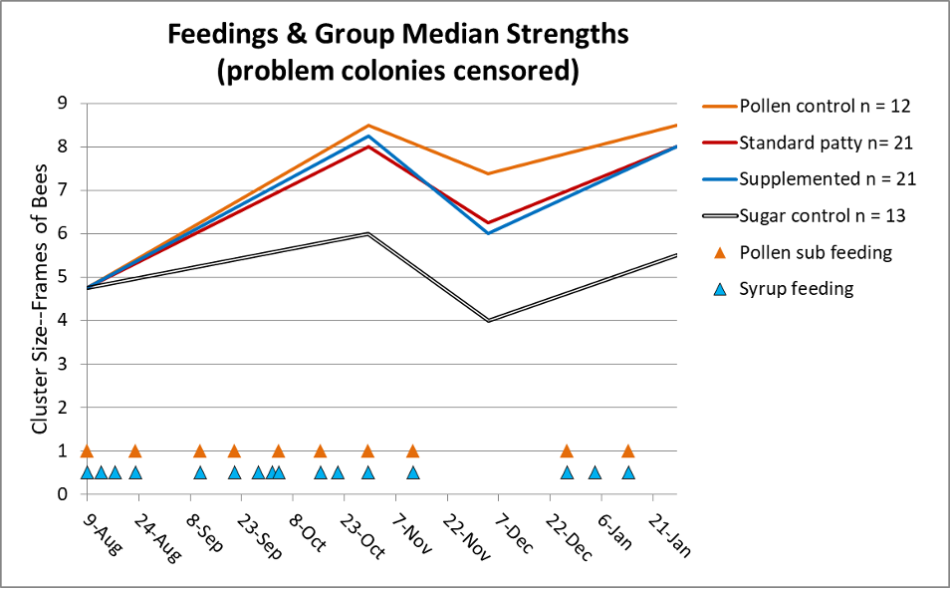
Fig. 1 Results from my 2018-2019 field trial [[3]], in which we were able to nearly double the size of the clusters between August and November. But in my 2020 trial in the same yard (Yard E), with many colonies starting even stronger and fed the best subs, overall they decreased in size over the same time period. I was really curious about why the difference!
So I made a list of every possible stimulatory or inhibitory contributing factor involved in colony buildup that I could think of, and went through them one by one.
THE HIVES
Hive configuration
We’ve tried growing summer nucs in 5-frame boxes, “5 over 5s” (two nuc boxes stacked one above the other), in single deeps and double deeps. In general, it appears that colonies do best in relatively “snug” cavities, without a large amount of extra space around the cluster. The “5 over 5” configuration (thanks to Mike Palmer) appears to help small clusters to expand their broodnests (going upward rather than sideways). In this case, during setup, we started with decent-size clusters in the bottom boxes, and added a box of drawn comb above.
Availability of suitable drawn comb
It’s easier for colonies to expand on drawn comb than on foundation. We had stocked the test hives with 8 frames of good-quality drawn comb in each hive body, flanked by a frame of foundation on each side. So the colonies were not restricted by lack of drawn comb.
THE BEES
Quality of the queens
All the queens were of my own stock, reared that spring, and had been laying since April. All exhibited solid brood patterns at the start of the trial. So the lack of growth was not likely due to the queens.
Colony size
We hadn’t started the trial with nucs — not only did the colonies start with an average of nearly 8 frames covered with bees, but the correlation between starting strength and November strength was actually negative(Figure 2).
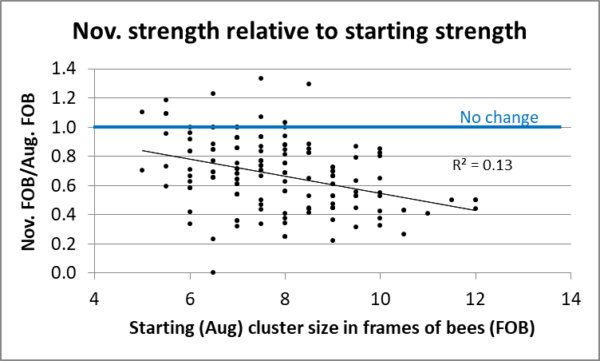
Fig 2 Each data point’s height on the y-axis indicates its cluster size in November (when clusters were tighter due to the cold weather), relative to its starting size. Surprisingly, there was a slight trend for the larger the colony in August, to grade disproportionally smaller in November. Go figure!
Practical application: Well, it doesn’t appear that the problem was due to starting with weak colonies.
NUTRITION
Sugar: nectar, syrup, honey; incoming or stored
As pointed out by Somerville [[4]]:
The loss of the stimulating impact of nectar will also equate to a reduction in the area of brood being cared for by the colony. The provision of nectar continues to keep the brood area “open” and population replacement at a high or expanding level. This stimulus can be artificially created by the provision of sugar syrup.
If there is no fresh nectar available to foraging bees or sugar syrup is not being provided to the colony, then it is a dubious exercise to feed pollen supplements. Otherwise a pollen supplement may be an expensive method of feeding sugar.
An experimental limitation was that I didn’t want to feed these fairly strong double-deep colonies “too much” syrup, since I expected them to grow rapidly, and didn’t want to plug out the broodnests or add additional supers. The intent of this trial was not to fill supers with sugar “honey,” but rather to build up colony strength in double deeps.
So we fed 1:1 sugar syrup along with the pollen sub patties, and I carefully monitored for the presence of open cells of nectar/sugar syrup around the broodnests to make sure that lack of syrup wasn’t a limiting factor. All colonies put on plenty of weight during the trial — to the extent that toward autumn I had to swap frames of honey out of some hives to maintain some open drawn comb above their broodnests for expansion.
Practical application: It’s possible that had we fed sugar syrup daily, that the colonies might have grown more, but since the colonies continuously stored syrup “honey,” I question whether syrup (artificial nectar) was the limiting factor. Plus, our full-sized colonies typically respond to pollen sub alone, even without feeding syrup.
Protein: pollen or substitute, incoming or stored
There was seldom much pollen visible in the combs, but patties of pollen sub were always available, centered over the cluster between the two brood chambers. If the cluster moved to the upper box, we reversed the brood chambers.
Practical application: The colonies did not lack for “available” protein, since they had patties of pollen sub (some containing plenty of natural pollen) in the hive at all times. But I will return to the subject of where it was placed.
THE ENVIRONMENT AND WEATHER
Daylength, time of Season
I’ve not seen evidence that shorter days or time of year prevent colonies from building up. In areas with eucalyptus honey flows, colonies will vigorously brood up and grow in November through the winter solstice. And in my arid climate, in September and October, our full-size colonies respond immediately to the feeding of pollen sub, and expand their broodnests prior to winter. So I have no reason to believe that the day length in August inhibits colony buildup.
Temperature
It was unusually hot and dry during the trial; I’ll go into this further on.
Practical application: We in California are acutely aware of climate change (Figure 3).
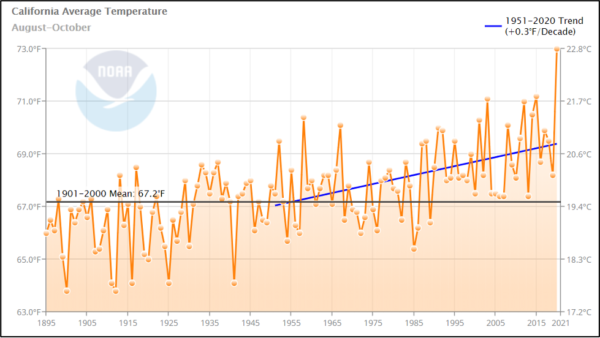
Fig. 3 I keep asking, is it just me growing old, or are our summer temperatures indeed getting hotter? The blue line indicates the trend over my lifetime. My sons are too young to remember “how it used to be.” Our warming climate is not only causing extreme weather and worse fires, but also affecting agriculture, the local flora, and beekeeping. Chart from NOAA [[5]].
Practical application: Beekeepers need to prepare for “the new normal” as far as temperature change and weather extremes.
BEES, MONARCHS, AND OTHER INSECTS
Honey bees maintain a broodnest temperature of around 94-95°F, and optimal flight temperature for foragers is around 72-77°F, although foraging activity will continue at temperatures up to about 100°F before declining [[6]]. Temperatures above that start to approach the thermal limit of honey bees. Dalmon [[7]] found that the survivability of European honey bees starts to drop off rapidly at temperatures above 104°F. What happens at higher temperatures is that the enzymes that drive metabolic processes in the bees cease functioning. And this brings us to a very important concern as our climate warms.
Dr. Orley (Chip) Taylor recently published three excellent articles on the effect of higher temperatures on Monarch butterflies [[8]], and makes the point that:
It should be clear that everything I’ve just described for monarchs applies to honey bees, bumble bees, solitary bees, other pollinators and most other insects. I can envision scenarios based on the above that account for population declines of all of these organisms.
Practical application: As our climate warms and we continue to set new high temperature records (116°F in Portland, for cryin’ out loud), honey bees (as well as beekeepers) will need to adapt. Some of our commercial stocks may not be able to handle hotter weather, so we may be forced to explore bee bloodlines that are better adapted to higher temperatures.
I found an interesting study from the Tucson Lab, in which they compared the temperature tolerance of “domestic” stock to that of a locally-adapted feral colony (Figure 4).
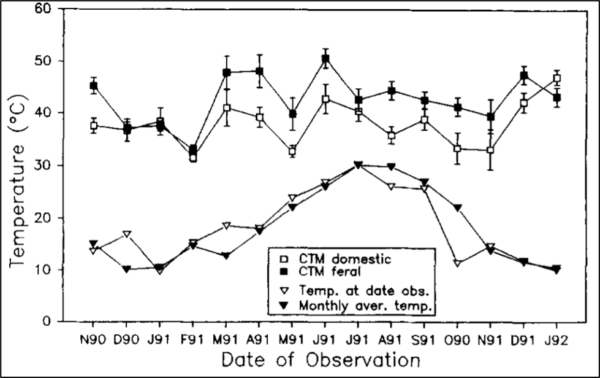
Fig 4 Atmowidjojo [[9]] compared the critical thermal maxima (CMT) for bees collected from the entrance of a single locally-adapted feral colony in Arizona to those from a USDA colony of “domestic” bees, over the course of 14 months. Surprisingly, there wasn’t a clear correlation between monthly ambient temperature and the thermal tolerance of the bees. But the feral bees clearly were more tolerant of high temperatures.
Practical application: Although the above study involved bees from only two colonies, it’s clear that the “domestic” stock would have trouble at temperatures above 104°F (40°C = 104°F; 50°C = 122°F)..
Temperature tolerance of races of bees
So how about the various races of Apis mellifera? Kovak [[10]] determined the thermal limits of Carniolans (carnica) vs. Italians (ligustica):
We found differences in several traits, suggesting that A. m. ligustica populations can tolerate a high temperature exposure better than A. m. carnica populations. This surely represents a feature of adaptation of A. m. ligusticapopulations to the warmer environment of the South European climate.
Curious, I checked to see what sort of high temperatures that Italian bees evolved in. Historical average August high temperatures for most cities in Italy seldom exceeded 85°F [[11]], suggesting that they may not be adapted for higher temperatures.
So how about races of bees from hotter areas, such as the Arabian honey bee, Apis mellifera jemenitica? I was able to find some informative studies from Saudi Arabia.
Alqarni [[12]] notes that:
Central Saudi Arabia has the highest summer temperatures for the Arabian Peninsula, and it is in this region where only A. m. jemenitica survives, while other subspecies fail to persist.
He found that jemenitica forages earlier and to a greater extent at high temps than does A. m. carnica.
The optimum humidity for the survival of eggs and successful larval emergence for our “domestic” bees is 90-95% RH [[13]], with the rate of emergence dropping to as low as zero at 50% RH. Of interest, Al-Ghamdi [[14]] found that greater tolerance of lower humidity by the eggs of A. m. jemenitica allows for more successful brood rearing in the desert than by European bee races.
As far as adult bees, Alqarni [[15]] compared the performance of jemenitica to that of mellifera and carnica, and found that jemenitica loses less body water and forages more extensively at high temperatures than either European race.
Practical application: In correspondence, Dr. Alqarni suggested that “As conditions continue getting hotter and drier in your area, you might consider testing different bee lines.” That’s a sobering thought — similar to how the rest of the ag industry is being forced to adapt to a warming planet, we beekeepers may have to start selecting for more heat-tolerant bees. So could my Italian mongrels simply have hit their thermal limit for buildup during a hot summer?
CAN WE BLAME HIGH TEMPERATURE ALONE?
The colonies in my trial never shut down broodrearing until November, but they maintained only about a single comb’s worth of brood, despite being continually supplied with nutritious pollen subs. So could their lack of expansion have been due to the high temperatures?
The Sierra Foothills are typically warm and dry during summer, but a recent NOAA report [[16]] confirmed that the September – November period in 2020 was one of the hottest on record. And it wasn’t just the heat — over the course of the August-October period we received only 0.05 inch of total rainfall.
The colonies in Yard E gave me a chance to compare performance between the trial in 2018, in which the colonies grew, to that in 2020, when they tended to shrink. In order to see just how different the weather was in 2020 compared to 2018, I searched for data records for personal weather stations in the area. Unfortunately, I could only find one with data for both years at about 400 ft higher elevation, where it is slightly cooler. That said, I downloaded and graphed out the weather data for the two years for comparison (Figure 5).
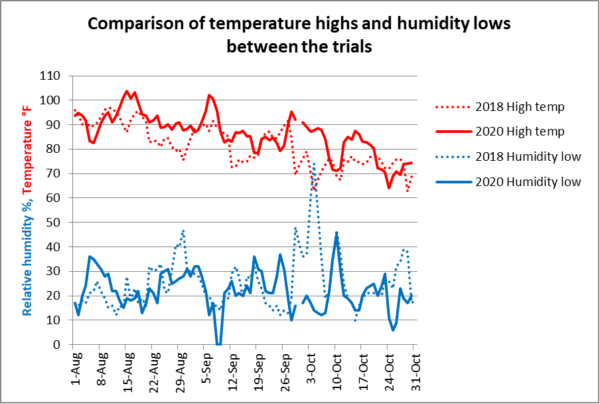
Fig. 5 Compare the daily temperature highs and humidity lows over the course of the 2020 trial (solid lines), compared to that of 2018, when colonies grew well in response to feeding (dotted lines). Not only were the temperatures often higher in 2020, but the humidities were often lower. Our “normal” average September high is 81°F, and for October only 71°F, so 2020 was indeed hotter than “normal.” Data from a local personal weather station [[17]].
Oh boy, I’d surely nailed it! It was obvious that in 2020 we simply reached the thermal tolerance limit for small colonies of my Italian mongrels — it was just too danged hot for them to grow!
Practical advice: Any time you feel cocksure about something, remember that the easiest person to fool is always yourself. And that’s exactly what I’d done. In the words of Thomas Huxley: “The great tragedy of science [is] — the slaying of a beautiful hypothesis by an ugly fact.”
Indeed, when later carefully reviewing my data, I noticed a couple of “ugly facts” which indeed slayed my beautiful explanatory hypothesis. The ugliest fact had to do with the surprise nectar/pollen flow that occurred in mid-August.
A BEAUTIFUL EXPLANATORY HYPOTHESIS SLAIN
We have an invasive weed in Northern California called yellow star thistle. Star thistle produces a very tasty honey, but in my experience, the plant doesn’t produce much nectar and pollen unless daytime highs exceed 95°F. Due to drought, we’d written off the possibility of a star thistle flow when we started feeding pollen sub on 13 August, so were completely surprised when the bees in the two lower-elevation test yards started bringing in loads of nectar and pollen only a few days later (Figure 6).
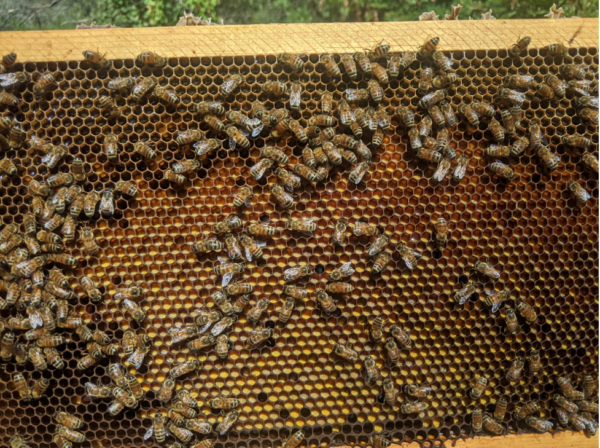
Fig. 6 The bees briefly filled the combs with fresh yellow star thistle nectar and pollen. This photo of freshly-stored pollen was taken on 16 August, on which date the temperature reached 105 F (the daily high for the preceding week had only once fallen below 95 F). Not shown is that in response, the colonies temporarily ramped up brood rearing to the max.
After taking the above photo, the temperature dropped, and so did the nectar/pollen flow. The bees shortly thereafter started to shrink their broodnests. So let’s compare that burst of broodrearing to daytime temperatures and humidities (Figure 7).
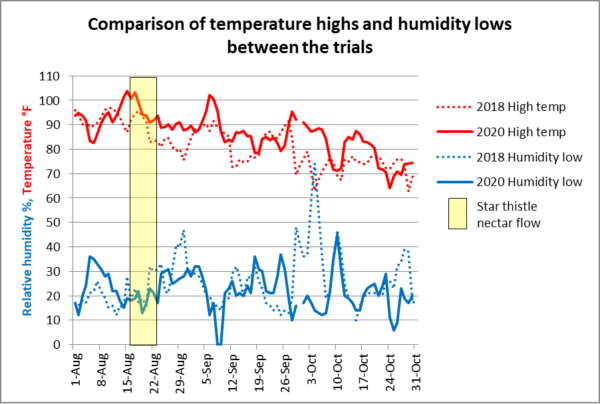
Fig. 7 I overlaid when the thistle flow occurred (from 16-24 August). Note that it occurred during some of the highest temperatures and lowest humidities during the course of the trial. By 4 September, despite cooler temperatures and having some thistle beebread remaining in the side combs of the broodnest, the nurse bees had already begun cutting back on the amount of jelly being fed to larvae, and the broodnests were shrinking. We resumed feeding pollen sub on 10 September.
A beautiful explanatory hypothesis slain: The colonies brooded up big time during the hottest temperatures of the entire trial. So the overall lack of colony growth can’t be blamed on temperature alone.
BACK TO THE DRAWING BOARD
So let’s review what I observed:
- Continual feeding of pollen sub patties along with ½ gallon of 1:1 sugar syrup was not enough “stimulation” to get the bees to expand their broodnests during the hot summer of 2020 (in Yard H there was no thistle flow, and no broodnest expansion).
- On the other hand, despite daily high temps well over 100°F, weak colonies were able to rapidly expand their broodnests when a nectar and pollen flow occurred.
- Once the nectar and pollen flow stopped, the colonies rapidly decreased brood rearing, despite there being plenty of recently-stored beebread, and combs full of ripening nectar.
So how can we explain why I couldn’t get the colonies to grow well during the rest of the trial, despite providing them continuously with patties of pollen sub along with ½ gallon feedings of 1:1 sugar syrup? Next month I’ll explore whether it had to do with water, humidity, or perhaps where we placed the pollen sub patties.
REFERENCES
[1] Connor, L (2006) Making & Wintering Summer Increase. http://www.wicwas.com/sites/default/files/articles/Bee_Culture/BC2006-07.pdf
[2] http://scientificbeekeeping.com/a-comparative-test-of-the-pollen-sub/
[3] http://scientificbeekeeping.com/an-experiment-to-improve-pollen-sub-part-2/
[4] Somerville, Doug (2005) Fat Bees Skinny Bees, A manual on honey bee nutrition for beekeepers. https://rirdc.infoservices.com.au/items/05-054
[5] https://www.ncdc.noaa.gov/cag/statewide/time-series
[6] https://extension.umaine.edu/ipm/background-honeybee-flight-activity-index/
Caron and Connor give a wider range: Caron, D & L Connor (2013) Honey Bee Biology and Beekeeping. Wicwas Press.
[7] Dalmon, A, et al (2019) Temperature-driven changes in viral loads in the honey bee Apis mellifera. Journal of Invertebrate Pathology Volume 160: 87-94.
[8] https://monarchwatch.org/blog/2021/01/19/insect-population-dynamics/
https://monarchwatch.org/blog/2020/02/10/why-monarchs-are-an-enzyme-part-1/
https://monarchwatch.org/blog/2020/02/25/why-monarchs-are-an-enzyme-part-2/
[9] Atmowidjojo, A, et al (1997) Temperature tolerance and water balance in feral and domestic honey bees, Apis mellifera L. Camp. Biochem. Physiol. Vol. 118A(4): 1399-1403.
[10] Kovak, H, et al (2014) Metabolism and upper thermal limits of Apis mellifera carnica and A. m. ligustica.Apidologie 45:664–677.
[11] https://www.currentresults.com/Weather/Italy/temperature-august.php
[12] Alqarni, A, et al (2011) The indigenous honey bees of Saudi Arabia (Hymenoptera, Apidae, Apis mellifera jemenitica Ruttner): Their natural history and role in beekeeping. ZooKeys 134: 83–98.
[13] Doull K.M. 1976. The effects of different humidities on the hatching of the eggs of honeybees. Apidologie 7: 61–66.
[14] Al-Ghamdi A, et al (2014) Hatching rates and some characteristics of Yemeni and Carniolan honey bee eggs. J Entomol Zool Stud 2:06–10.
[15] Alqarni, A (2006) Tolerance of summer temperature in imported and indigenous honeybee Apis mellifera L. races in central Saudi Arabia. Saudi Journal of Biological Sciences 13(2) 123-127.
[16] Shoemaker, C (2021) NWS Sacramento Fall 2020 Climate Summary.
[17] Thanks to KCAGRASS28.



